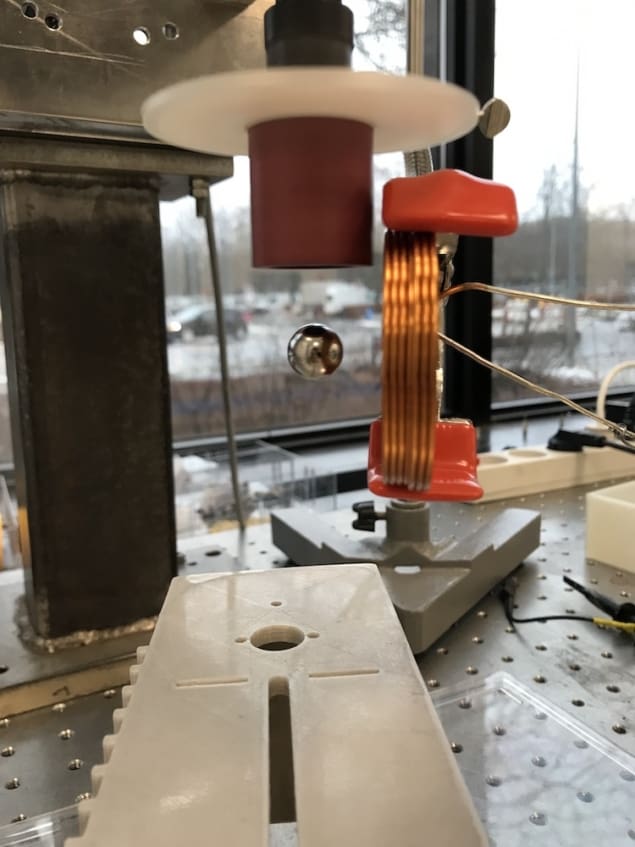
Magnetic levitation is already employed in systems such as Maglev trains, flywheels and high-speed machinery. Now researchers at the Technical University of Denmark have given this old technology a fresh twist by explaining how a magnet can be levitated simply by rotating another magnet of a similar size near it. This unusual effect was first demonstrated by an electronics/computer and software engineer, Hamdi Ucar, in 2021, and the TU-Denmark team say it could be exploited in the contactless handling of objects or used to trap and manipulate ferromagnetic microparticles.
There are three main types of magnetic levitation. In the first, known as active magnetic stabilization, a control system supplies the magnetic force required keep the levitating object balanced. The second, termed electrodynamic suspension, is used in Maglev trains. Here, a moving magnet induces a current in a stationary conductor, producing a repulsive force that increases with the speed of the moving magnet. The last category, called spin-stabilized levitation, features a levitating magnet that spins at around 500 revolutions per minute (rpm) and remains stable thanks to the gyroscopic effect.
A rotor and a floater
The new type of levitation involves two magnets. The first, dubbed the “rotor”, is mounted on a motor with its north and south poles oriented perpendicular to its rotation axis and made to rotate at velocities of around 10 000 rpm. In the TU-Denmark team’s experiments, this magnet was spherical, 19 mm in diameter and made from neodymium-iron-boron.
The second magnet – the “floater” – is placed near the rotor, begins to spin automatically, and then moves towards the rotor until it hovers in space a few centimetres below it. The floater precesses with the same frequency as the rotor and its magnetization is oriented close to the axis of rotation and towards the like pole of the rotor magnet. If disturbed, a restoring force moves it back to its equilibrium position.
“It is quite surprising that magnetic levitation develops in such as relatively simple system,” says Rasmus Bjørk, a physicist at TU-Denmark who led the study together with Frederik Laust Durhus and Joachim Marco Hermansen.
A counterintuitive configuration
Using computer simulations that take into account the magnetostatic interactions between the two magnets, the team found that the new type of levitation appears to be caused by a combination of the gyroscopic effect and magnetostatic dipole-dipole coupling.
“It is intuitive to all that the magnetostatic force that one magnet exerts on another can be both attractive and repulsive,” explains Durhuus. “Without rotation, the free magnet will rotate so the force becomes purely attractive and then the magnets will collide into each other. What makes the new magnetic levitation system so special is that the rotation itself allows the floater to remain in a counterintuitive configuration, nearly perpendicular to the rotor’s field, where the magnetostatic force both attracts and repels it.”

Magnetic trap keeps a superconducting microsphere levitated and stable
This process then leads to a mid-air energy minimum in the dipole interaction potential, he tells Physics World. This minimum was revealed using the team’s computer modelling, and it is here that the floater can levitate stably.
While applications of the new type of magnetic levitation are difficult to predict at this stage, the researchers say that contactless handing of objects (by robots, for example) is one obvious possibility. “Other possibilities will depend on the extent to which the phenomenon can be up- or down-scaled and how low the energy cost will be,” Durhuus says. “This will require further investigation.”
They detail their study in Physical Review Applied.
- SEO Powered Content & PR Distribution. Get Amplified Today.
- PlatoData.Network Vertical Generative Ai. Empower Yourself. Access Here.
- PlatoAiStream. Web3 Intelligence. Knowledge Amplified. Access Here.
- PlatoESG. Carbon, CleanTech, Energy, Environment, Solar, Waste Management. Access Here.
- PlatoHealth. Biotech and Clinical Trials Intelligence. Access Here.
- Source: https://physicsworld.com/a/new-type-of-magnetic-levitation-makes-its-debut/



